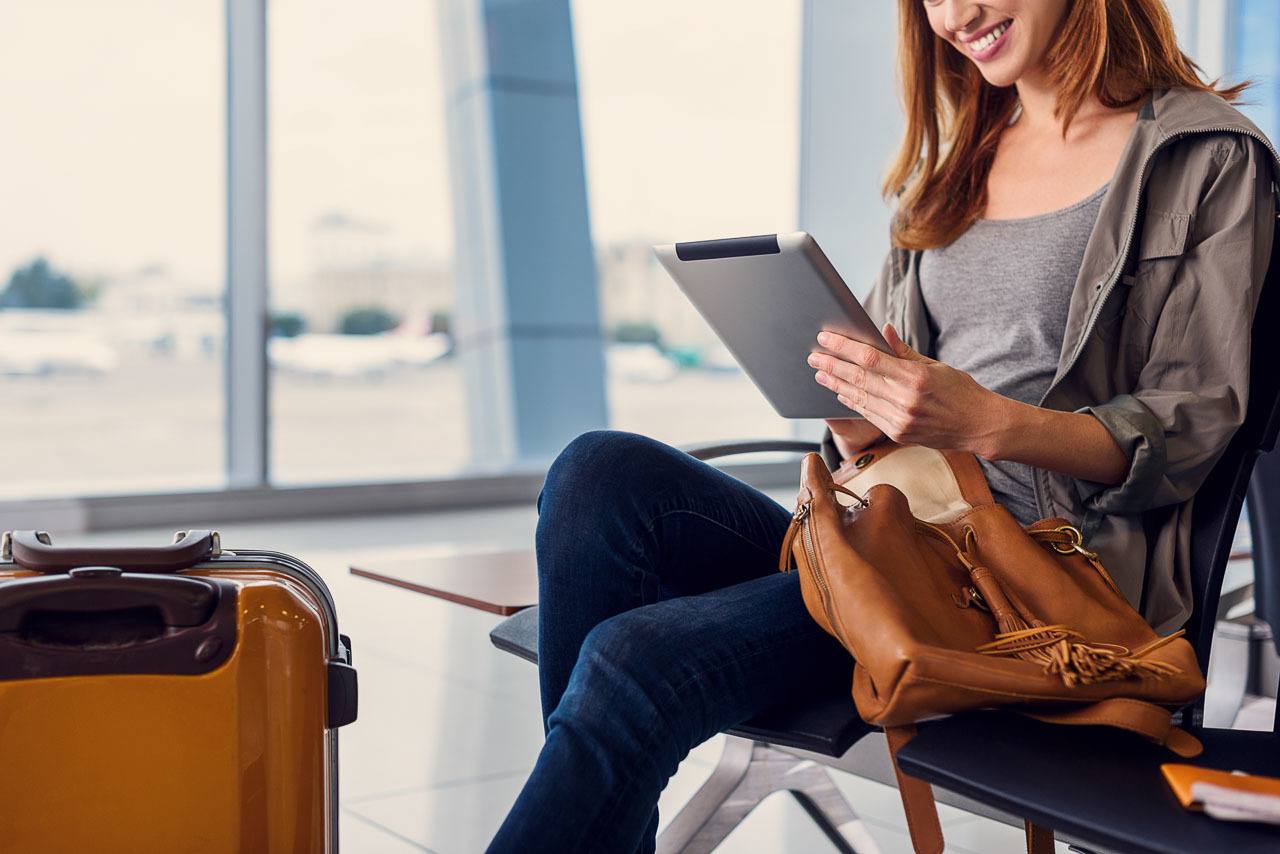Some of our links are affiliated, we will earn a commission when you buy a service or product. This will have no extra cost for you. For further info please refer to our Privacy Policy
Is traveling with a tablet the best option for you? Or should you consider taking your laptop, or flying only with your phone?
Here are a few tips to help you choose wisely, and how to travel with a tablet safely.
Are you gearing up for your next big adventure, and you’re a true minimalist? For you, nothing can get in the way of traveling as light as possible.
But maybe you’re a digital nomad and you need to work while you travel. Or, maybe you just want a bigger screen for research or entertainment purposes.
If any of these rings true for you, you should consider traveling with a tablet. Tablets are lighter than laptops, and bringing one with you is likely much easier than you think.
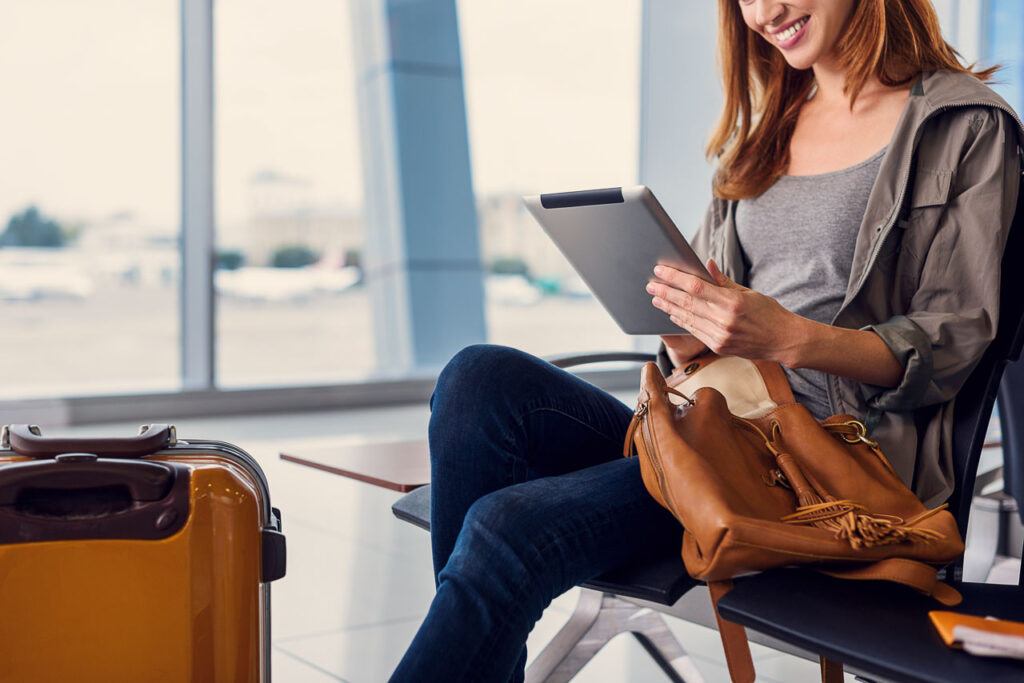
Below is a comprehensive overview of what it’s like to travel with a tablet, especially on a plane.
We talk about the advantages and disadvantages of a tablet. How to travel with a tablet, from security for tablets to carrying it with your luggage and using it in airports and abroad. What are the best tablets for traveling, and more tips to make the most of your tablet or iPad during the trip.
The good and the bad of traveling with a tablet
Before getting into the nitty-gritty, here’s a summary of the advantages and disadvantages of tablets for travel. There are so many benefits, but it pays to be aware of the trade-offs as well.
Pros of traveling with a tablet
- If you’ve ever traveled with a laptop, you know that nowadays they’re slim and have a lightweight design – tablets even more so. To give you an idea, an Apple iPad weighs barely more than 1/3 of a MacBook Air.
- For some lines of work, laptops are overkill. Graphic designers, artists, and writers don’t always need the hefty processing power or advanced features of a computer.
- Some android tablets and Ipads come with the capacity for cellular data, which means you can access the internet from your tablet just as you would with your cell phone. In this case, you just need to buy a tablet with a SIM card slot.
- If you were considering traveling with only your smartphone, a tablet will be immensely helpful when you need to conduct some research on your next destination or the accommodation options in your area. The larger screen just makes it much easier to stay organized, make plans and read all the travel guides.
- Along the same vein, the big screen of a tablet makes watching movies and TV shows much more enjoyable (and don’t pretend you never need a “day off” from full-time travel, and that you like to watch movies on a phone screen!).
Cons of traveling with a tablet
- It’s just a fact that tablets don’t have the same scale of processing power or user options as a laptop. If you need to do any serious video or photo editing, or if your work requires some beefier applications, a tablet won’t be your best bet. In this case, Ipads might be a better option, offering a faster processor.
- This is obvious, but tablets are expensive; the more valuables you travel with, the more you have to lose if you’re unfortunate enough to be the victim of a robbery. Traveling is usually very safe, but it helps to be aware of worst-case scenarios—more about keeping your tablet safe later on.
Air travel with a tablet – What you need to know
Unfortunately, a process as beautiful as flying through the air thousands of feet above the ground can sometimes be such a hassle — and yet, it’s the truth. Flying with a tablet will complicate things a bit, but not enough to be a material concern.

Boarding a plane with a tablet – airport security
In general, airline security for tablets is the same as airline security for laptops. As you’re going through the checkpoint, the most important thing is to make sure you take your tablet out of your bag and place it in a bin by itself, with nothing underneath it or on top of it.
If you’re wondering whether you can take tablets on a plane, the answer is yes; there’s no need to store your tablet in a checked bag unless you want to. On the contrary, it’s almost always better to carry it on the plane with you, for two main reasons:
- It’s easier to keep your tablet protected when it’s in your carry-on bag. Airline workers are notoriously “unfriendly” towards checked bags.
- You can watch movies or get some work done on the plane if you have your tablet in your carry-on.
That being said, if for whatever reason you do feel like you want to store your tablet in a checked bag, just make sure to really protect it. If you have a sleeve, keep it in there, and maybe even surround it with some softer items in your bag, like clothes.

Using your tablet in an airport or plane
There are two types of people in the world: those who get to the airport early, and those who get to the airport early. If you’re in the second group, you might want to make your way over to a charging station, usually provided for free at most airports.
If you have a long flight coming up, don’t board with a 6% battery.
Once you’re on the plane, definitely keep your tablet travel bag under your seat; your tablet is much safer on the floor than if it is stuffed into the overhead compartments.
This also just makes it easier to access your tablet as needed. And of course, don’t forget to switch your tablet into airplane mode (flight mode) when instructed by the flight crew!
In most cases, whether you’re on the plane or just waiting in the airport, you’ll need to use provided Wi-Fi connections to access the internet. Usually, airports offer complimentary Wi-Fi to anyone on the premises, though usually, these types of connections are notoriously slow.
When you’re in the air, you’ll have to pay for an in-flight Wi-Fi connection, which may or may not be worth it depending on your flight’s length.
For either of these scenarios, it’s important to be aware of the risks of connecting your tablet to open networks — more on this in the below section.
Using your tablet abroad safely
It’s just a fact that anytime you use a provided Wi-Fi connection while traveling, you’re potentially exposing yourself to hackers and other cybersecurity risks.
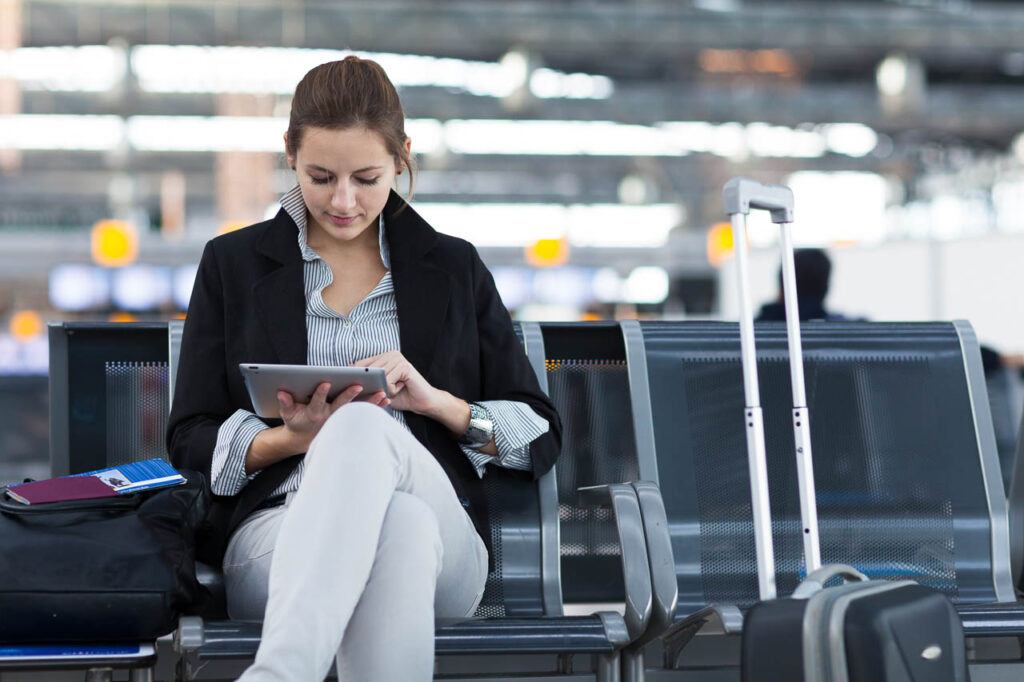
The best way to hedge against this risk is to use a secure virtual private network or VPN for tablets.
A VPN is basically a secure “tunnel” through which all your data is funneled, and this makes it nearly impossible for your data to be compromised. Check out Express VPN for the best VPNs for tablets!
Here are two other safe ways to connect a tablet to the internet while abroad:
- Use your phone’s personal hotspot. In most countries, you can purchase a local SIM card for a very reasonable price. As long as the SIM provides 4G data or faster, you should be able to connect to the hotspot from your tablet with no problems.
- Buy a tablet with a cellular data plan. As time goes by, more and more tablets seem to be offering this feature. If your tablet has this capacity, you can just put a local SIM card directly into your tablet, access the internet, and skip the whole hotspot thing.
VPN is not only about safety. Another good reason to invest in a VPN for your tablet is that you can access your movies, Netflix series, and documentaries from your country that might not be available in foreign countries. That way you can really use your travel tablet as an entertainment device.
In our case, the VPN is also handy to access our banking system in Brazil and other governmental websites that are blocked abroad.
Things to remember when traveling with a tablet
It’s important to remember that a tablet is a valuable investment. Below are some crucial considerations, both to protect your investment and to make your life just a bit easier.
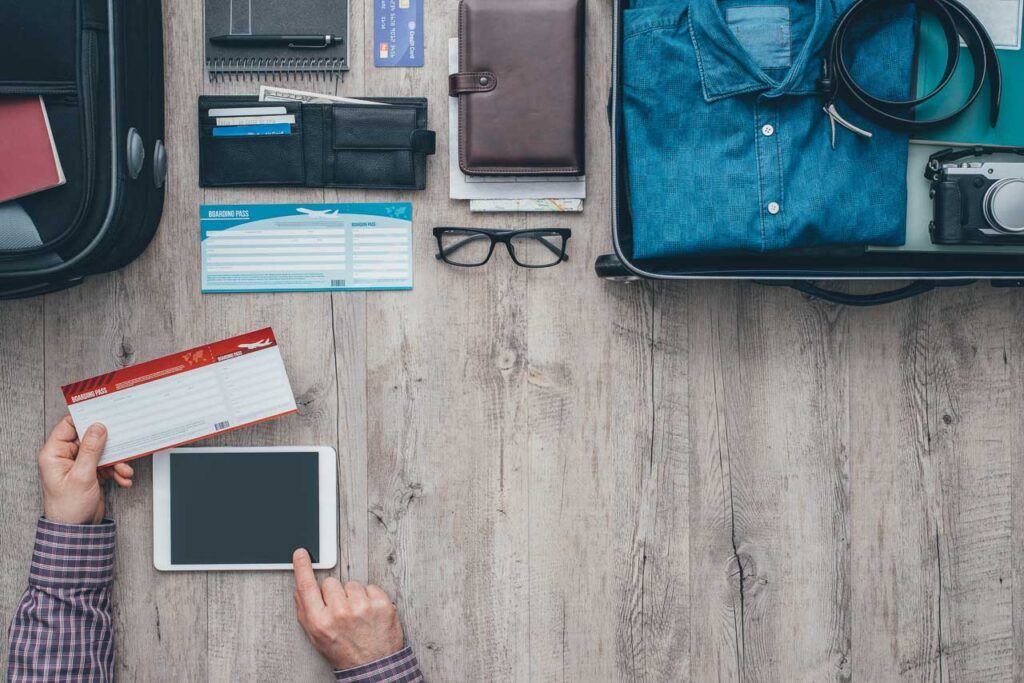
How to protect your tablet for traveling
First of all, definitely keep your tablet in a protective case. Even something sleek and lightweight can make a huge difference, as there’s possibly no worse feeling in the world than dropping a pristine, uncased tablet on the sidewalk.
It’s also 110% worth it to spend some money on a good-quality carry-on backpack or a strong and comfy daypack with a dedicated tablet or laptop section.
Keep in mind that your tablet carry case or bag needs to meet the airline carry-on luggage requirements.
During your trip, you’re likely to be stuck in the rain, dropping your stuff on dirty floors, and bumping into other travelers on crowded trains or metros. It’s really nice to be able to rest easy amidst all the chaos, knowing your tablet is safe and secure.
And if you really want to go the extra mile, consider purchasing a separate sleeve for your tablet, which can also double as a protective placemat when you’re working on scratch-inducing surfaces.
Travel Insurance for you and your tablet
We always recommend you don’t embark on a long trip without a good travel insurance plan. Again, the more valuables you have with you, the more at risk you are for the misfortunes of the open road.
HeyMondo and SafetyWing are some of our favorite companies, but for more of an in-depth look, check out our Travel Insurance Guide. This guide is super handy for people planning a long trip or going to different destinations.
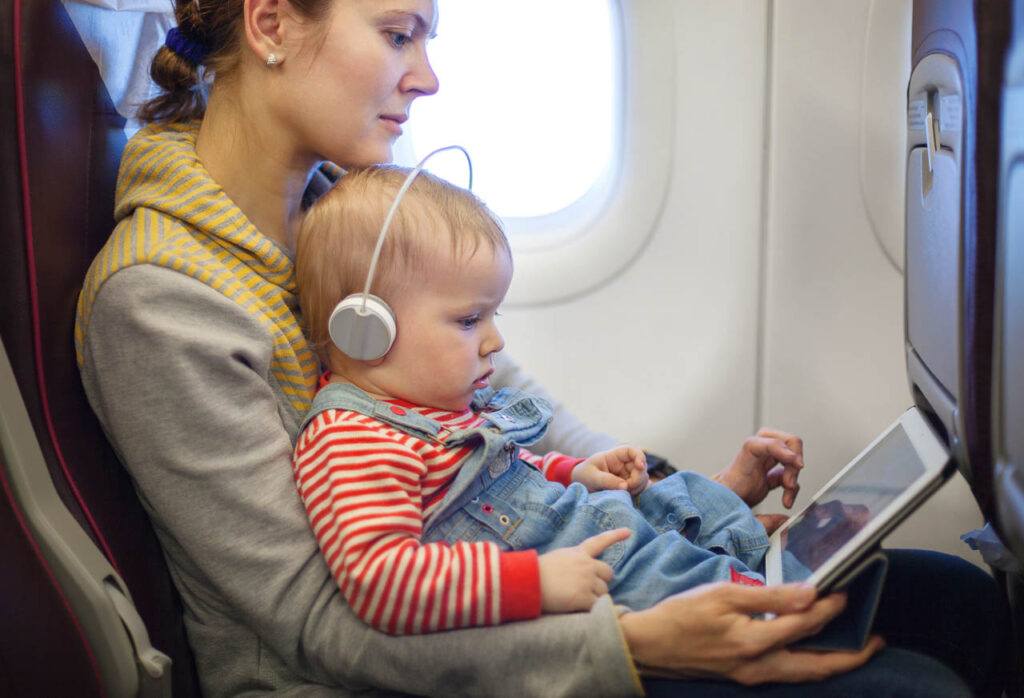
How to choose a tablet for travel
In case you don’t have a tablet yet, or a considering buying a new one, here are a few things you should take into consideration when buying a tablet for travel:
- Budget and usage: there is a wide range of tablets in the market, and the price can vary widely. So the first thing you need to do before buying any compact tablet or a super powerful device is to think of how much you want to invest and your needs. If it’s for work, it might be worth spending more. If it’s for your child, you can think of a brand that offers kid-friendly features. Or if you are going on an adventure or expedition, then a durable design can be your best option.
- Design and size: check the weight, size, and if it’s nice to hold and comfortable to use. Does it feel fragile or strong? If you are worried about luggage space and weight, don’t forget to also check the size and weight of the charge, cables, and surface pen, as it will all add up to your bag.
- Operational System: you can have iOS (all products from Apple), Android, Amazon Fire OS, and Microsoft Windows.
- Internal specs: you need to take into consideration if you need a powerful processor for work or for using specific applications. Also, check the RAM and all the info about the machine itself.
- Screen type: resolution, definition, and tablet screen size. Premium tablets and Ipads will have better screen definition and vivid colors than cheap tablets.
- Battery: is very important to check the hours of battery life and how long it takes to get completely charged. A long-lasting battery is essential for long trips. Yes, you can charge a tablet on planes, also buses and trains, but keep in mind that you should always have your devices charged when passing the security checks. If you are traveling with kids, you probably want those extra hours of battery to keep them entertained.
- Storage: as with any laptop or mobile device, your tablet will have inbuilt storage and some will also offer a MicroSD card slot (expandable storage).
- Connectivity: tablets and Ipads can connect to the internet via Wi-Fi, some models also offer the option of a SIM card slot. All of them have a connection via Bluetooth (for pairing with stereo speakers, earphones, or pairing with your phone). If you already have a MacBook, an iPhone, or an Apple Watch you might consider buying an Ipad to have an easy connection between all devices.
The best tablets for travel worth buying:
- Apple Ipad
- Samsung Galaxy
- Microsoft Surface
Those are good brands that offer a variety of portable tablets with a wide range of features, sizes, and prices, being a good choice for travelers.
Accessories for your tablet
Do some research on the types of outlets used in your destination country (or countries), and purchase the right adapter—but if you’ll be moving around frequently, consider purchasing a worldwide travel adapter.
These are usually quite bulky, but since they work for every outlet type, you’ll never be stuck high and dry, unable to charge. And, speaking of charging, you might want to bring along an extra cable, just in case.
You could also invest in an external hard drive or solid-state drive if you need extra storage space. That can be handy to upload your photos and videos from the trip, especially if you are in a place with slow internet and you can’t save them on cloud storage.
If you are planning to use your tablet for work, answering emails, or any other task that involves typing, then you can buy a proper keyboard. There are some foldable keyboards for tablets that are lightweight, easy to carry and to connect to your tablet, especially if it’s an android device.
They might not be the most comfortable keyboard, but they are helpful. If you buy one, you might consider getting a keyboard cover, a slim one, just for protection.
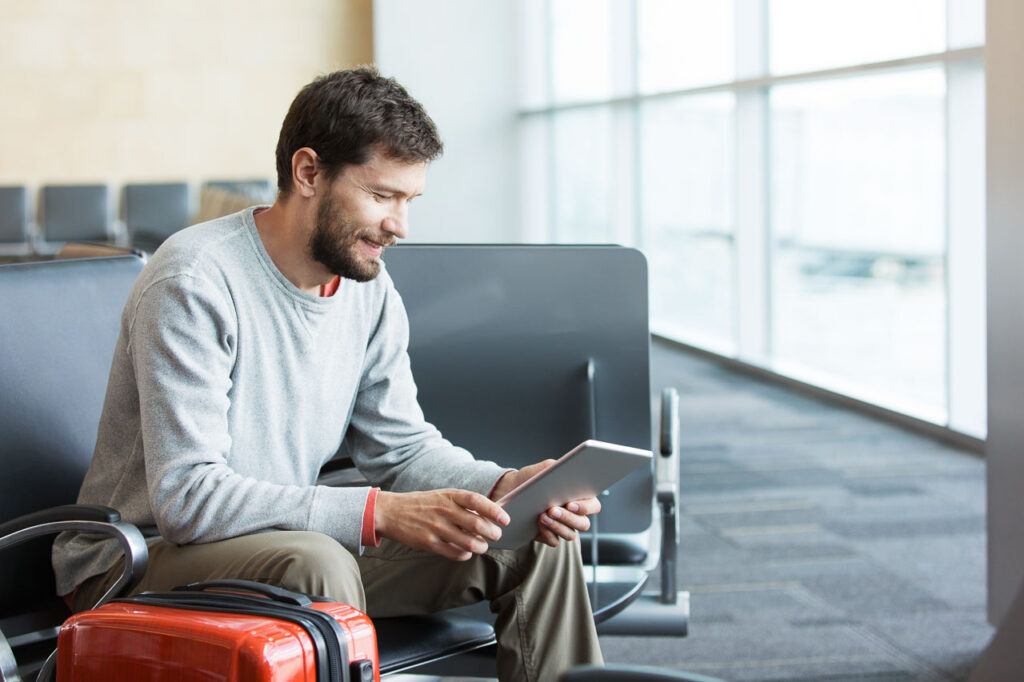
Traveling with tablet wrap-up!
We can say that if you don’t need a laptop for work while traveling, then a tablet is the way to go.
With so many device options for travelers, it is easy to find a tablet that fits your budget, needs, and luggage.
Remember that larger tables are better for road trips or when you don’t need to worry about baggage weight. A compact device is better for backpacking, adventure, or a shorter trip with less luggage.
Buying a tablet for traveling is the first step. You also have to keep your device protected while using it abroad and when carrying it from one destination to another.
We hope our tips help you decide which portable device to take on your next trip and make the most of your tablet on the air and land.
Did you like these tips about traveling with a laptop? Save it on Pinterest!


